Parrots are being more commonly sold in the pet industry and veterinary teams are likely to be increasingly presented with avian patients for either routine examinations or illness. It is important to be able to make a full assessment of the individual. This includes physical assessments, home environment and husbandry care that is appropriate to the species presented. It is also important to understand how to care for parrots in a veterinary environment by following correct husbandry advice. There are many different species and families of parrot being kept as companion animals and it is unrealistic to know them all. However, this article should provide guidance and understanding of what to look for to aid care and recovery of parrots.
Assessing health
Looking after the health of parrots occurs even before the patient presents to the veterinary clinic. It is important for front-of-house staff to discuss appropriate carry cages with owners prior to the parrot's veterinary appointment to prevent stress, injury or escape. A safe carrier should be an appropriate size for the patient and should have hard, sturdy sides made from either plastic, acrylic or wire (Figure 1). A perch should be provided, and the bottom of the carrier should have an absorbent bedding such as newspaper or a towel. The door to the carrier should be large enough to allow easy removal of the bird, and it is recommended that the cage be covered with a light towel or sheet during travel to the clinic (Fear Free LLC, 2021). Carriers made of thin wood, wicker or cardboard are inappropriate as parrots may chew their way out of the box (Figure 2).
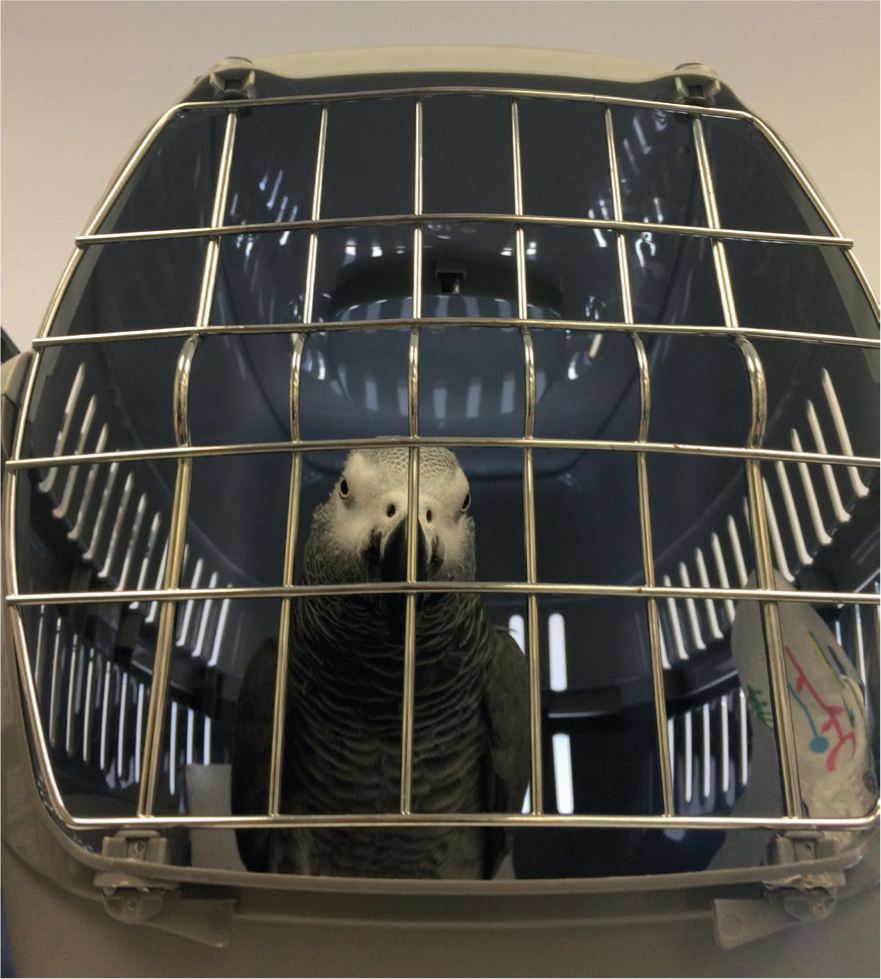
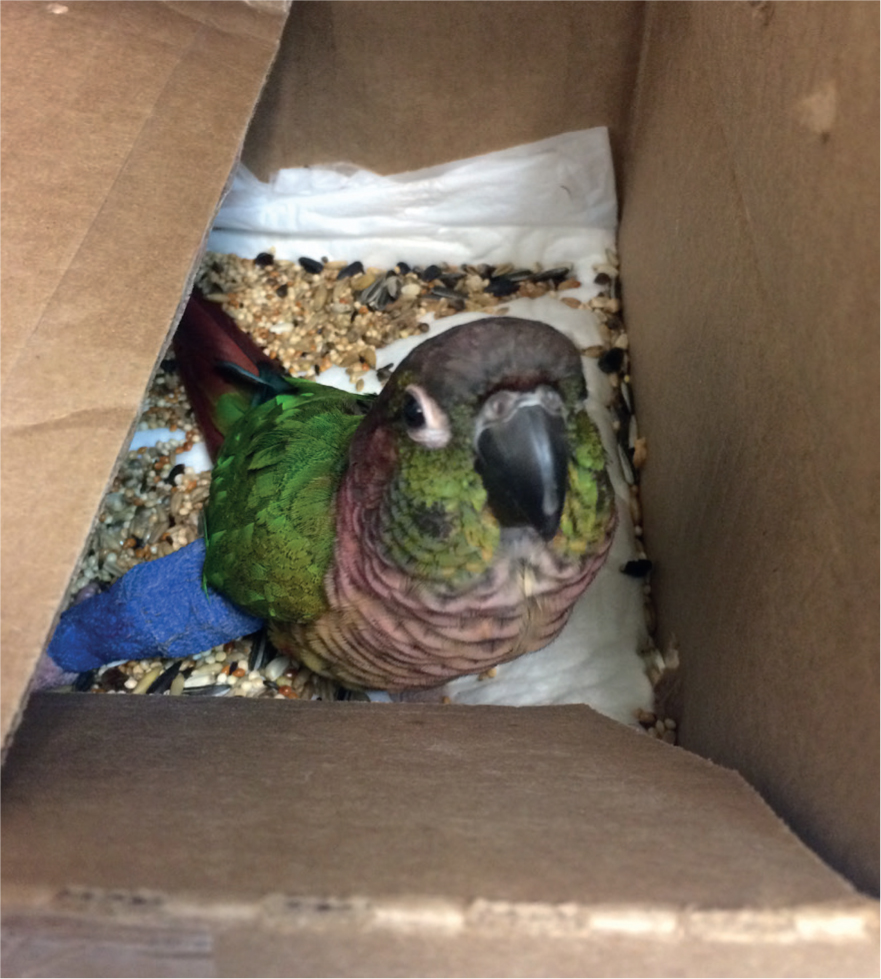
When a bird is first presented, a distance examination should be performed. This involves watching the bird in the carrier or cage to assess its demeanour, posture and behaviour. It is important to observe the bird for at least a few minutes to reduce ‘masking behaviours’ where ill birds will try to mask the signs of illness when presented to a new environment (Doneley and Bayón del Rio, 2016).
If the bird is masking, it will initially present with eyes open, interested and interacting with its surroundings and vocalising. After several minutes, it will then begin to become quieter, sit hunched or fluffed on the perch, have squinting eyes or close its eyes entirely, or even tuck its head under its wing and sleep. These are signs that the bird is severely ill as a healthy bird would not fluff up or fall asleep in a new and unfamiliar environment. Distance examinations can also be performed remotely, with the use of video cameras. However, this is not always feasible within the constraints of a consultation.
A healthy bird will be interested in its surroundings with wide, open eyes and often will display ‘pinning’ of the pupil, where the pupils expand and contract, signalling interest (Doneley and Bayón del Rio, 2016). Feathers will be slicked down to the skin and streamlined, with no aberrant feathers or feathers sticking out perpendicular to the body. The nares will be free from discharge and the feathers around the nares and mouth should be clean with no dried discharge. The beak should be smooth with no flakes or areas of crumbling.
Some signs of illness can be subtle but can also be identified on a distance examination. These can include dystrophic, dark or dull feathers; discharge from the nares; dried mucus around the mouth and nares indicative of regurgitation; a bobbing of the tail with each breath; shivering; and a wide-based stance or sitting with fluffed feathers (Figure 3).
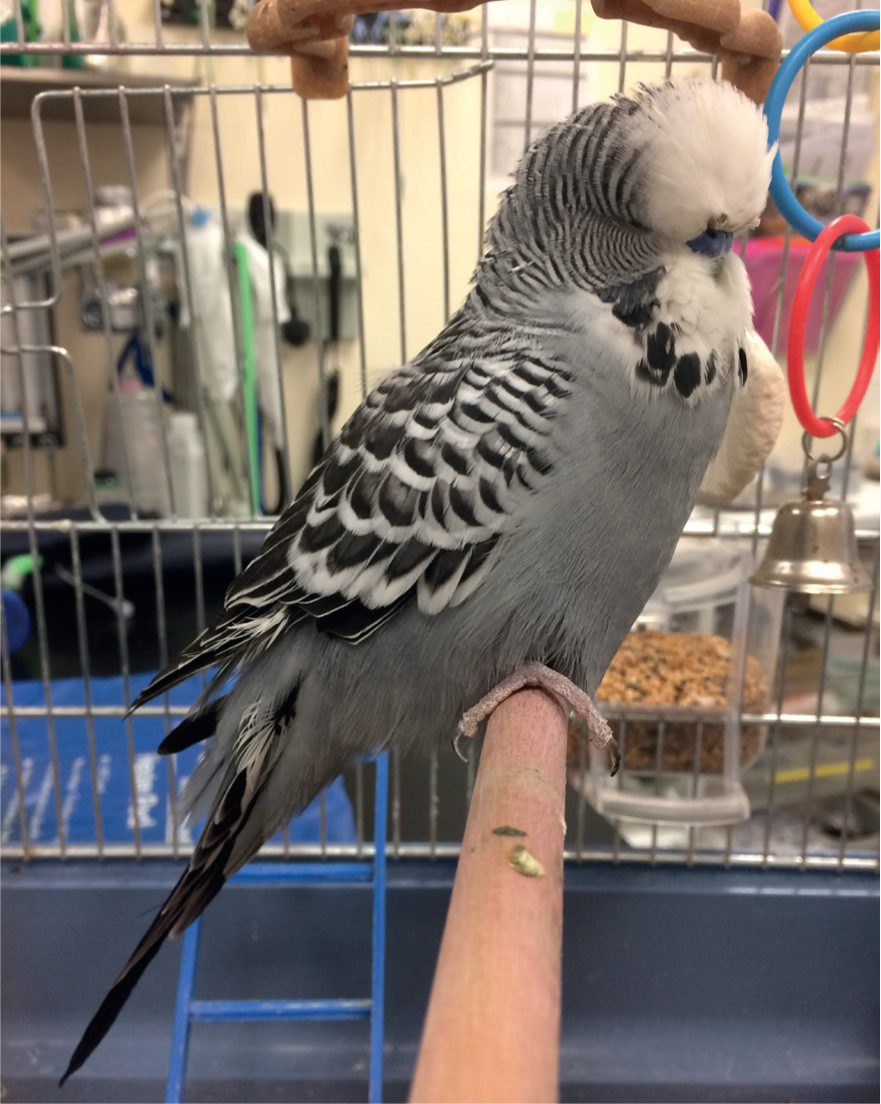
A distance examination is also a good time to assess the droppings in the bottom of the cage, looking for signs of faecal colour changes, diarrhoea, polyuria or evidence of blood. Regurgitation will appear different to droppings, which are usually composed of three components — urine, urates and faeces (Doneley, 2016). Regurgitation is often undigested food, fluid or mucus, usually found on the sides of the cage as well as the ground, and visible around the bird's beak.
Distance examinations can be performed at the same time as a thorough history taking (Doneley, 2011). Talking to the client and not looking at the bird directly gives the patient time to settle and become more comfortable with its surroundings, and is less threatening than staring directly at the carrier and the bird (Wilson, 2007). A patient's experience with travel and veterinary clinics, as well as its level of socialisation, will affect the behaviours displayed during the distance examination. For example, aviary birds with very little human contact should be much more alert and wary, whereas a cockatiel kept in the home and well socialised would be far more relaxed comparatively.
Capturing the patient for a physical examination can be stressful for both patient and handler. It is best to approach the patient in a non-threatening manner, ideally by encouraging the patient to step onto the hand and then down onto the table or a scale. Some patients can be fully examined sitting on a perch or towel, and examining this way should be encouraged. The historic approach of quickly grabbing parrots in a towel over their back and wings should be avoided as it is very similar to the way that predators capture prey and can result in significant stress to the patient (Welle and Wilson, 2006; Wilson, 2007; Fear Free LLC, 2021). In some cases, towel restraint may become necessary; however, most birds will tolerate gentle wrapping in a towel after the towel has been introduced in a non-threatening way (Figure 4) (Welle and Wilson, 2006; Wilson, 2007; Cook, 2012). This may take extra time but will help prevent the patient from becoming scared of towels, and can make administering medications and further physical examinations less stressful.
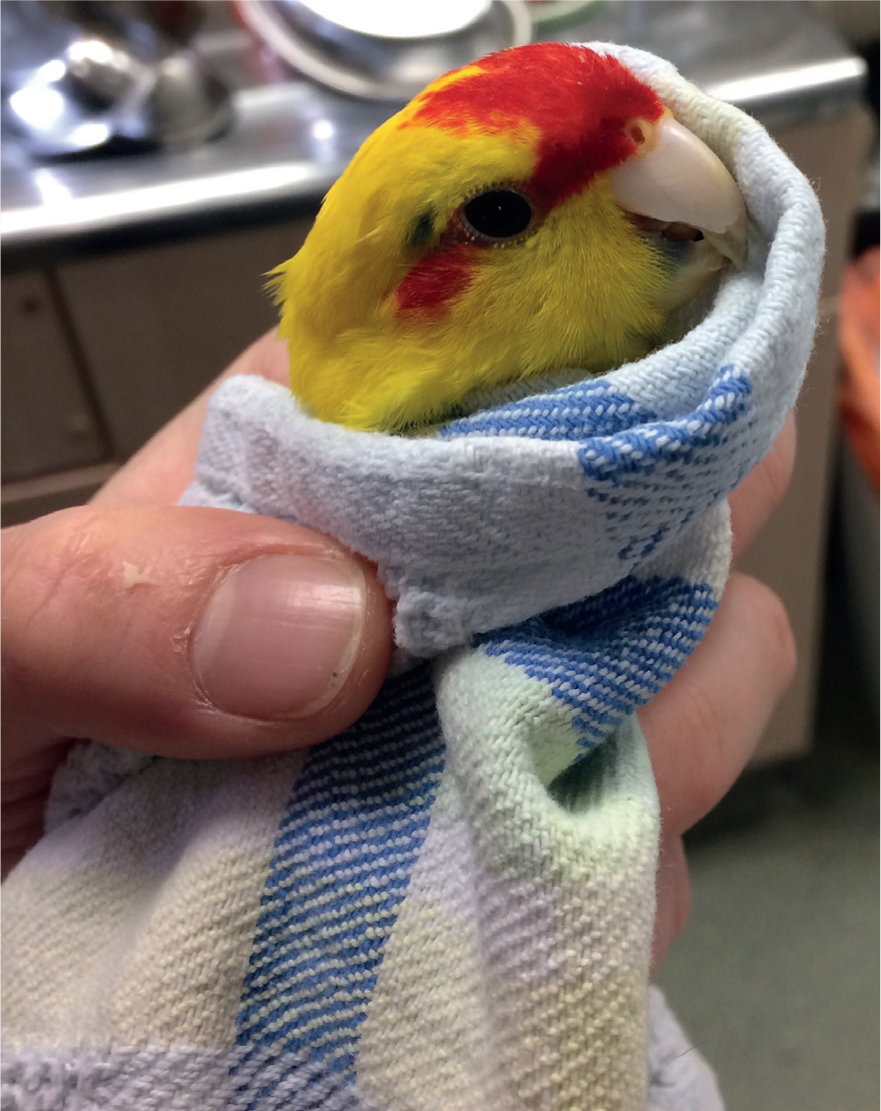
The bird's eyes should be examined to ensure they are open, bright and clear of discharge. The nares should also be inspected to make sure they are clear of discharge and no rhinoliths are present. The beak can be opened gently to assess the oral cavity, tongue and choana. The beak itself should be examined for signs of crumbling, flaking or discolouration. A body condition score can be performed by gently palpating the pectoral muscles and keel bone (Doneley, 2011). The heart and air sacs can be auscultated using a stethoscope, listening for abnormal cardiac noises, wheezing or crackles. The coelomic cavity can be gently palpated, caudal to the keel, and assessed for any evidence of distension or palpable masses. The pectoral and pelvic limbs can be examined in turn, gently palpating along them and extending the joints as you do so. The primary and secondary feathers of the wings should also be inspected, as well as the overall plumage. Examine the vent and uropygeal or preen gland. The plantar aspect of both feet should also be examined to look for signs of pododermatitis or hyperkeratosis.
The authors recommend that parrots are presented to a veterinary surgeon for a routine health check every 1–2 years. This can help to identify subtle indicators of disease, nutritional deficiencies or changes in weight or condition. At the time of this examination, routine haematology and biochemistry can be performed in older birds, similar to geriatric consultations in older dog and cat species.
Husbandry
At the presentation of any pet, it is important to understand husbandry provided and husbandry required for the individual. Often the husbandry required for certain parrot species is not fully clear, as opinions often vary among ‘experts’ and internet searches. Many common species such as budgerigars, cockatiels and African greys are placed under the category ‘parrots’; however, each species has their own unique requirements that are important to know before seeing the parrot in practice.
Parrots can be classified into Old-World and New-World. Cockatoos (Figure 5), African greys (Psittacus erithacus), budgerigars (Melopsittacus undulatus), and cockatiels (Nymphicus hollandicus) are members of the Old-World classification and are native to Europe, Africa and Asian regions (Sparks and Soper, 1990). Amazons, macaws (Figure 6) and conures are members of the New-World classification and are native to South America and the American islands (Sparks and Soper, 1990). Knowing where they are native, can provide insight into their needs and environments in which they are found. If you cannot find specific data about that species, you can look for similar species in the same categories to aid husbandry assessments.
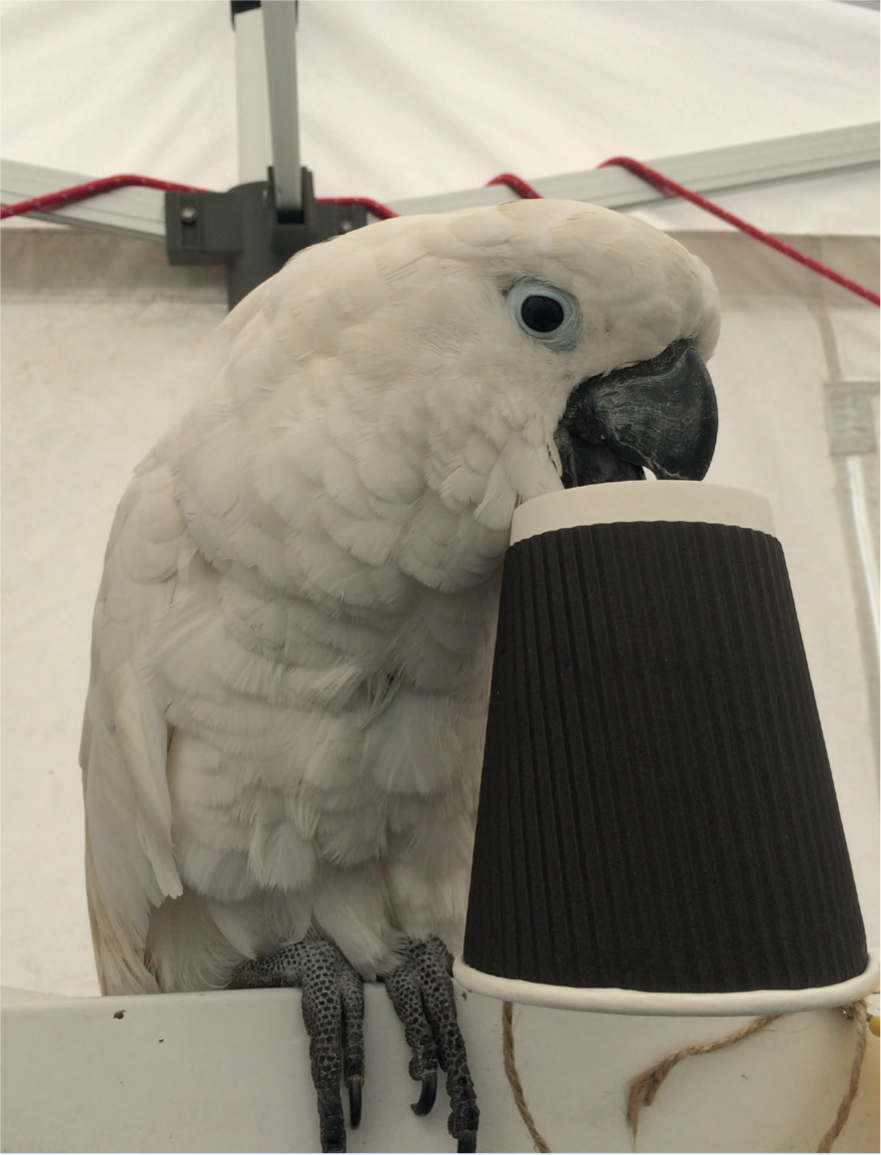
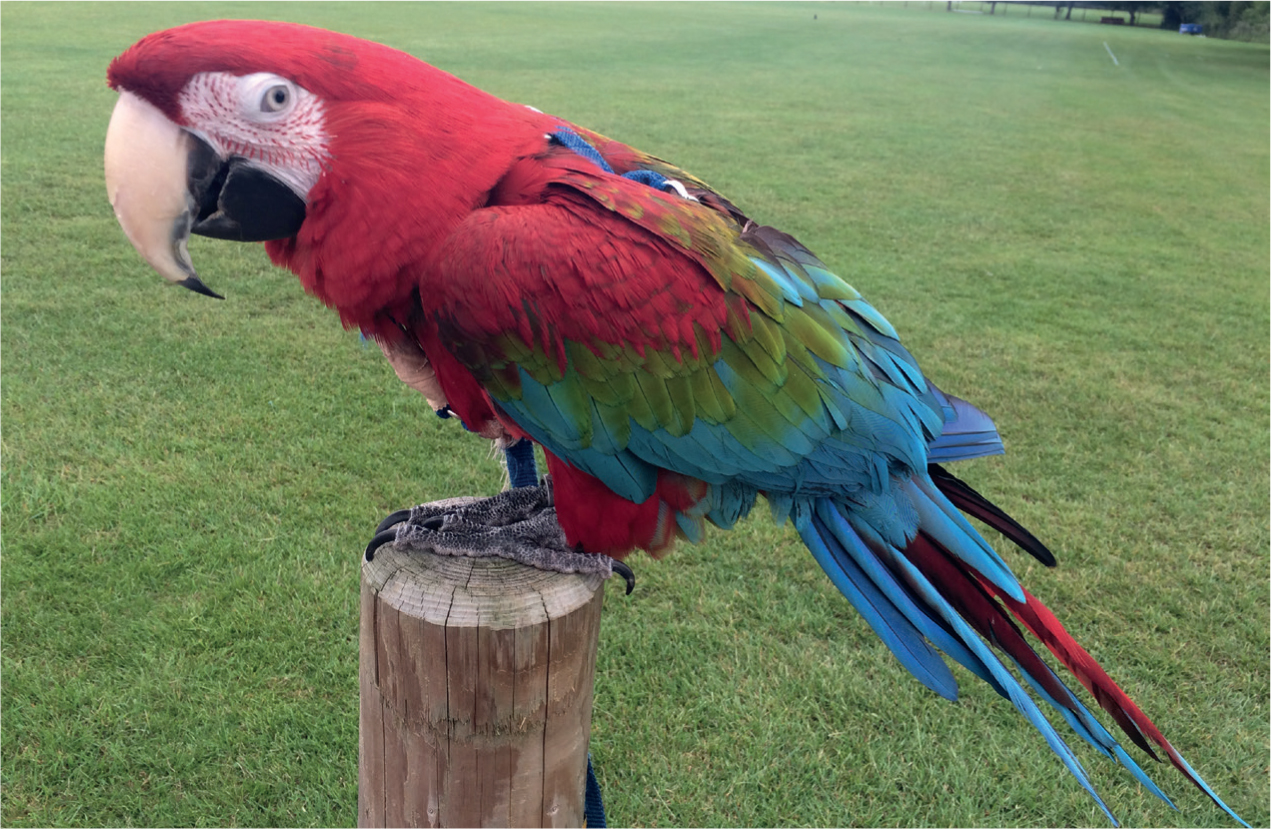
It should be understood that there are various ways in which a parrot can be kept. It is important that they have a safe enclosure and plenty of activity time. Many species of parrot, such as the cockatoo family and African grey family of parrots, would require a higher level of mental stimulation; otherwise, health problems such as mutilation may occur. Old-World parrots are known for their dusty nature; this can cause problems if housed in close proximity to New-World parrots, which have not evolved to manage the dust in their respiratory systems. Parrots should be housed safely away from other animals in the house regardless of whether they would be prey or predators; they all have the instinct and ability to harm if something untoward takes place. Aviaries can be suitable for parrots, however, ensuring heating is provided for colder periods or if being used as a ‘nice weather’ enclosure to allow them out into the aviary for enrichment and fresh air.
Key areas of husbandry to discuss with clients include diet, socialisation, enrichment, hygiene and access to house-hold toxins. Unless danger is imminent, inappropriate husbandry should not be corrected until the parrot is stable and healthy. However, any husbandry changes that are required should be discussed with the owner at the time of consultation, to be implemented once the patient has recovered.
Diet
There are many diet options for parrots and many opinions can be found when researching them. However, there are still key factors that should be addressed when looking at an ideal diet to suit the individual parrot, as well as the owner's circumstances and abilities (Koutos et al, 2001). These factors include the diet being correct for the species' metabolism, ensuring the diet is nutritionally balanced, assessing what the individual parrot actually eats (rather than leaving alone when offered), and the availability of the diet.
Smaller species, such as budgerigars, cockatiels, and conures, have a high metabolism and are designed to eat lots of food for their energy requirements. They have become naturally adapted to require low nutritional food, as this is what is readily available as a staple in the wild (Koutos et al, 2001). This contrasts with larger parrots that have a lower metabolism compared with smaller parrot species and are adapted for high nutritional, dense food. This is shown by the different foods available to them in their native habitat (Levey and Martinez del Rio, 2001).
High-fat foods, such as seeds, should be offered with caution as they will often provide low levels of vitamin A, vitamin E and calcium (Hess et al, 2002). Higher-fat foods are often found by clients to be more palatable to their parrots than healthier foods such as pellets or fresh fruits and vegetables. It is common to find individuals that are so ‘addicted’ to these seeds that they do not eat healthy food and require supplementations to make up for the lack of vitamins and minerals in their diets. Pelleted foods are recommended over seed-based diets, as they hold more nutrients and many manufactures have different varieties with vitamin and mineral profiles tailored to different species.
Sprouted seeds are increasing in popularity in diets for parrots as they are known to be higher in amino acids and protein levels compared with the same seeds being fed dry and unsprouted (Benincasa et al, 2019). However, there are risks associated with sprouting seeds should this be done incorrectly or in suboptimal conditions. These can include fungal infections, bacterial infections, and a poor nutritional balance (Lee, 2001). If sprouted seeds are offered, it is important to ask the clients about the ways in which they grow and provide these to ensure that it is done correctly. Seeds should be being kept in suitable dark conditions, rinsed regularly and only offered for a few hours at a time to reduce bacterial or fungal growth while being presented to the parrot.
Fresh food is also an important part of a parrot's diet and should be offered for all parrots. Fruits and vegetables are higher in vitamins and minerals than seed or pelleted diets, and are an excellent source for the individual. Fruits are often higher in sugars and can therefore be more palatable (Levey and Martinez del Rio, 2001), but the excess in sugars should be monitored as too much can cause obesity and behavioural problems. Vegetables are the preferred fresh food to be offered as they have less sugar than most fruits with similar vitamins and minerals, depending on the vegetable (Fidgett and Gardner, 2014). However, vegetables are often preferred less by fussier parrots and owners should encourage them to be eaten. It may require owner perseverance for getting the parrot to eat fresh foods, and there are many different presentation methods that can be used to help encourage eating healthily. Further reading can be found through Lafeber and also parrot cookbooks giving reliable varied recipes to encourage healthy eating.
While it is important to know what the owner feeds the parrot, it is equally important to understand what the parrot eats. While a parrot may be offered a balanced diet, they may not eat all the diet offered, and have favourites that are eaten in preference, leading to an unbalanced diet (Wissink-Argilaga and Pellett, 2015). It can be useful in these circumstances to reduce the level of favourite foods and ensure less preferential foods are offered in replacement to encourage balanced feeding.
Converting parrots onto more suitable diets can be difficult depending on the individual parrot, the owner and compliance. There are different ways in which owners can be advised to transition them into a new diet. These include the routine slow changes as recommended for dog and cat nutrition (day 1–3: 25% new, 75% old; day 4–6: 50% new, 50% old; day 7–10: 75% new, 25% old; day 11 onwards: 100% new) (Kaytee, ND). An alternative approach is to swap to the new food for the day with 1 hour of familiar/old food. This can encourage hunger and discovering the new food on searching for food. It is important in these cases to not continue this process for more than 3–5 days and monitor the weight, condition and demeanour of the individual at this time (Lamb, 2020). Some of the more difficult birds to convert onto a healthier diet can be encouraged by the owner pretending to eat it around the bird and offering it to them. This uses their flock instincts to trust what their other flock members are feeding on as being safe when they see that nothing negative is happening to them when they eat it (Lamb, 2020).
Ultraviolet (UV) light is important for the metabolism of calcium. UVB allows metabolism of vitamin D3, which aids the body in metabolising calcium to a usable form (Northern Parrots, 2020). UV light would usually be gained from parrots being outside in their natural habitat, but many parrots do not have access to this without a glass barrier, which blocks UVB rays. UVB lighting can be attached to or near the cage so that the perch can be used by the individual to gain their UV requirement. It should be ensured that wires of these lights are kept out of reach of the parrot. UV bulbs should be changed according to manufacturers' recommendations, which are commonly 6–12 months (Arcadia, 2021). Further reading on UV light for birds and the benefits can be found through Arcadia. Where UV light cannot be provided, supplementation with vitamin D3 can be provided instead.
Having the nutritional imbalance may be causes for ill health, including cardiac disease, respiratory disease, hepatic disease, reproductive disease, growth of lipaemic masses, immunocompromise, and impaired healing and recovery. These can be seen as a primary or secondary condition (Worell, 2012). Dietary deficiencies can manifest externally, with hypervitaminosis A, causing hyperplasia of the oral mucosa, rhinoliths inside the nares or feather discolouration (Figure 7). Having balanced nutrition is key to the prevention of ill health in parrots and providing the body with an ideal recovery environment when it is required (Wissink-Argilaga and Pellett, 2015).
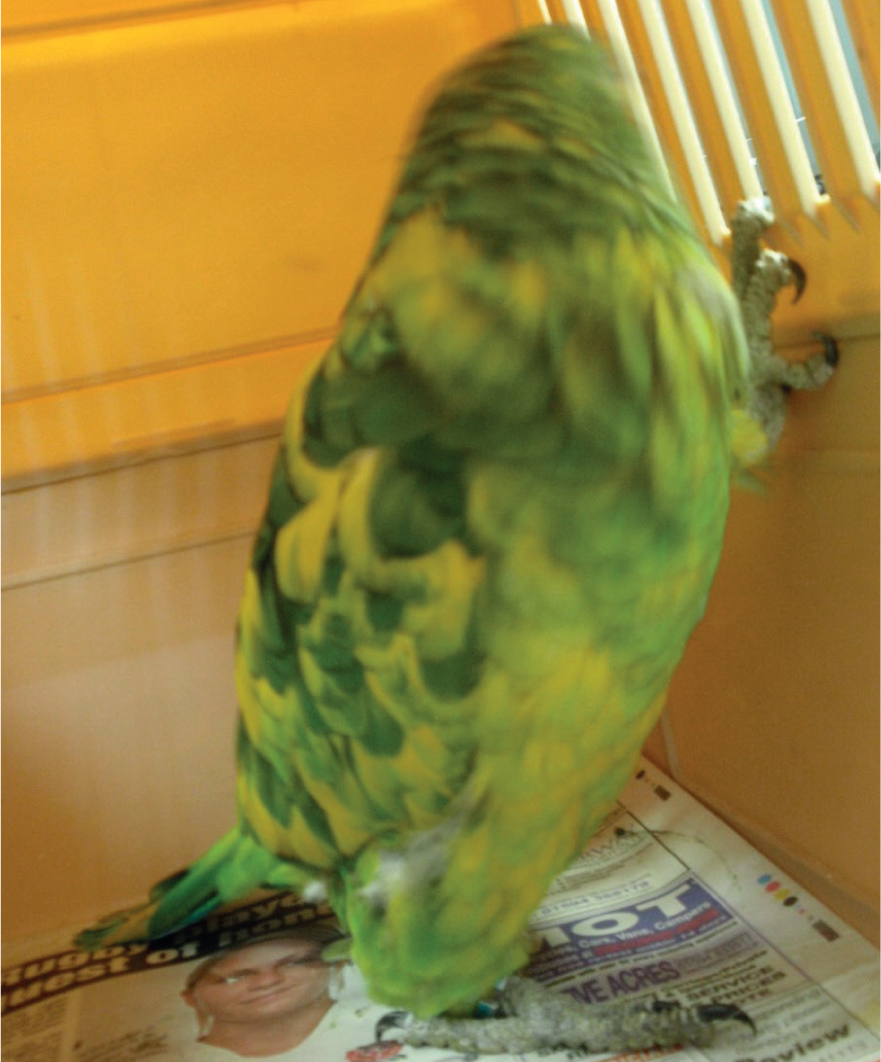
Socialisation
Parrots, similar to other animals, require some level of socialisation with their own or similar species and also humans. Most parrots are hand reared (Fox, 2006) using one of several possible methods. The consumer market prefers this as it produces a parrot that is used to humans and is likely to develop a relationship bond to the owners. Parentreared parrots are socialised with other birds but have an unpredictable reaction to humans, therefore making them less desirable to parrot owners.
Hand-reared parrots will understand humans as part of their flock, which can lead to numerous behavioural concerns, such as over-bonding, aggression, reproductive disease and crop infections as a result of regurgitation (Sant, 2006). Socialisation with other parrots is psychologically healthy to individuals as they obtain opportunities to express behaviour and develop a suitable response. It also allows more independence and an improved emotional state when the owner is not present, which can avoid stereotypical behaviours, such as feather destructive behaviour, pacing and screaming (Engebretson, 2006).
Knowing how well socialised a parrot is to humans will aid understanding of their response to an unfamiliar environment, such as a veterinary practice. Unsocialised birds are likely to show increased signs of nervousness, unsettlement, and withdrawn behaviour once they have settled down into the veterinary practice environment (Engebretson, 2006). Well-socialised parrots will present as more lively, inquisitive, and interactive with humans and other animals.
Knowing socialisation levels can also benefit compliance with a treatment plan. Parrots that are socialised to humans are likely to be much more compliant with medical care and recovery as the handling is not as stressful as it is with unsocialised birds that are fearful of humans (Verker et al, 2008). If the individual is socialised with other birds and spends time with other birds, care should be taken regarding the method of administration to prevent any companion birds having the patient's medication, especially if they share the same food sources (Baldwin et al, 2010). Considerations of social bonds and any overprotective behaviour shown by companion parrots may impede client compliance with administration.
Enrichment
Reports suggest that wild parrots spend up to 88% of their waking time active and engaged in behaviours such as foraging, nest making and socially interacting with their flock and partners (Rupley and Simone-Freilicher, 2015). Similar levels of activity should be seen in captive parrots; however, not being in their natural habitat can impact their ability to express this. Enrichment should serve a purpose to individuals, stimulating cognition and use of different senses as they work through the function of the enrichment (Figure 8).
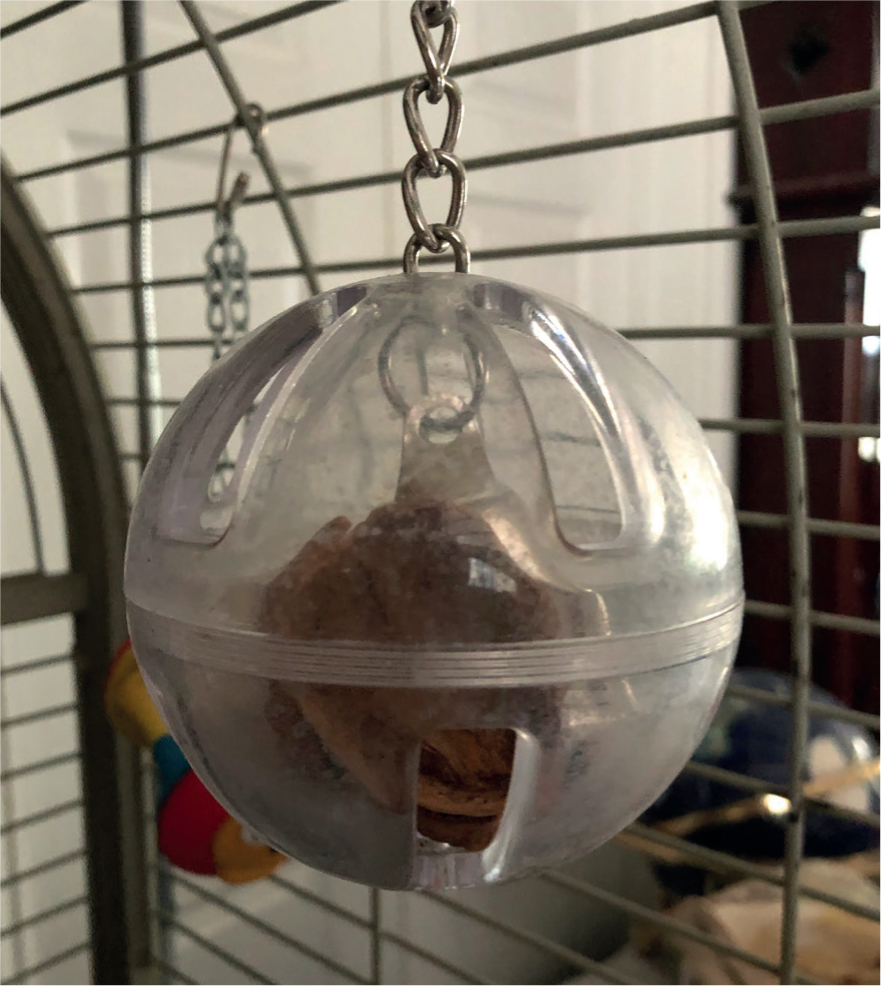
Enrichment should also include training tasks. These aid owner-pet relationships and bond, cognition of parrots, and also improve medical compliance when treating parrots. Training parrots should be a positive experience with lots of rewards and no negativity or punishment (Robar and Grindol, 2006). The authors suggest there are three key safety training behaviours that all parrots should know:
- Step up
- Come/recall
- No/stop.
These three behaviours allow owners to pick up parrots from places they should not be (step up); return to owners if they are in places inaccessible for humans, e.g. escaped and in a tree (come/recall); and to stop them carrying out a behaviour until the owner can remove the danger or remove the parrot from the danger (no/stop). These three behaviours can also be applied to train parrots that are less socialised around humans as they can be adapted such as through recall training back to a stand-alone perch, or stepping up onto a wooden perch or cushion rather than the human.
Enrichment provided for self-entertainment should be closely monitored and routinely inspected for signs of danger, which can cause ill health. It is important to know what enrichment toys are made of, as different materials contain toxins such as zinc and lead, which can cause toxicity when ingested (Pesek, 1999; Hayes and Swicegood, 2003; D'Arezzo and Shannon-Nunn, 2000). Rope toys can be chewed, and fibres ingested, potentially causing crop or intestinal blockages and complications (D'Arezzo and Shannon-Nunn, 2000; Livingstone, 2018). It is important to be aware of the enrichment being provided to a parrot presenting at the clinic to aid potential diagnosis or risks. Some owners are unaware of these dangers and, in these situations, education is key to preventing problems in the future.
Toxins
Parrots should always be supervised when out of their cages, as there are several household toxins that can prove very harmful to birds. Polytetrafluoroethrylene (PTFE), also known as Teflon, is found in many household items, including non-stick cookware, ovens and hairdryers (Wismer, 2016). When PTFE becomes hot, it releases carbonyl fluoride, hydrogen fluoride and perfluorisobutylene, which cause cardiac arrhythmias, pulmonary congestion and heart failure (Wismer, 2016). Clinical signs are acute and usually fatal, so it is recommended that items containing PTFE are not used in a household with parrots.
Nicotine in tobacco can cause chronic illness in parrots, especially if the owners smoke. Metabolites of nicotine have been shown to be present in higher levels in birds living in households where the owners smoked compared with non-smoking controls (Cray et al, 2005). Affected birds often show signs of respiratory disease such as wheezing, dyspnoea, con-junctivitis and dermatitis (Lightfoot and Yeager, 2008).
Heavy-metal toxicity is common in parrots, that investigate items with their mouths and are prone to ingesting small objects. In particular, zinc is a commonly encountered heavy metal within the average household, usually found as an alloy with other metals. Galvanised wire cages, bowls and toys have been identified as a source of zinc, as well as zippers, curtain pulls and jewellery (Lightfoot and Yeager, 2008). Clinical signs of heavy-metal toxicity include lethargy, anorexia, regurgitation, diarrhoea and ataxia (Wismer, 2016). Treatment involves administering chelating agents, removing the metal particles from the gastrointestinal tract if they are still present and identified on radiographs, and supportive care (Wismer, 2016).
Avocados are another ingested toxin that pet parrots may come into contact with. The persin found within its fruit, leaves and seeds has been shown to cause myocardia necrosis in birds (Lichtenberger and Richardson, 2008; Lightfoot and Yeager, 2008; Wismer, 2016). This usually develops 24–96 hours following ingestion, resulting in respiratory distress, oedema, cyanosis and death. Treatment includes supportive care alongside gastrointestinal decontamination, if the poison has been acutely ingested (Light-foot and Yeager, 2008).
Hygiene
It is important to assess the hygiene routine, as it can be a foundation or cause of ill health (Doneley, 2009), or can create a secondary condition by causing immunosuppression. Fresh water should be provided every day as a minimum but freshened more frequently if contaminated, especially when contaminated with faeces or food. Water contamination can lead to bacterial and/or fungal growth, so it is advisable not to place perches in areas above food and water sources to reduce the risk of dirtying the water.
After a period, food will start to spoil, and subsequently, bacteria can multiply which could then be eaten by the parrot and create a gastrointestinal infection. The amount of time depends on the type of food as well as the temperature of the day. Both spoiled food and contaminated water, as well as unclean bowls, can create infections and lead to absorption disturbances and secondary conditions.
If the environment (i.e. any area the bird is exposed to) is not maintained to a clean standard, it can increase risks for parasites and create an environment high in fungal spores (Doneley, 2009). This can cause immunosuppression and secondary conditions, or can cause a primary condition such as aspergillosis. It is important to discuss the environment as well as the cage with the owner, and ensure that the environment around the bird is cleaned to the same standard.
Conclusion
Parrots can make excellent companions, and are becoming far more popular pets, which means that they are more commonly presenting to veterinary clinics. A thorough investigation of husbandry at home and a distance examination should be performed prior to a full physical examination. Most birds will tolerate a physical examination restrained gently in a towel, and some well-socialised individuals will even tolerate an examination with no restraint at all. It is important to assess the bird's diet, husbandry, enrichment and overall environment in conjunction with its physical examination findings to enable a full understanding of the bird's health.
KEY POINTS
- Assessing the husbandry of companion parrots is important as part of the history taking process.
- Health issues can be caused by incorrect care and/or poor hygiene.
- It is important to know the species that is being presented and their specific husbandry requirements when advising clients.
- Enrichment is important for the mental and physical stimulation of companion parrots.
- A number of commonly encountered household items such as non-stick cookware, avocados and nicotine can be very harmful to parrots.


